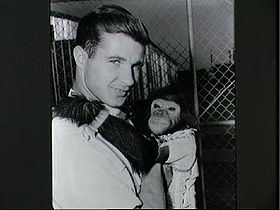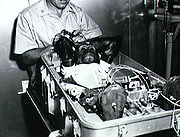.gif)
Enos (chimpanzee)
Encyclopedia


Chimpanzee
Chimpanzee, sometimes colloquially chimp, is the common name for the two extant species of ape in the genus Pan. The Congo River forms the boundary between the native habitat of the two species:...
that was launched into Earth orbit.
Enos was purchased from the Miami Rare Bird Farm on April 3, 1960. He completed more than 1,250 hours of training for his mission at the University of Kentucky
University of Kentucky
The University of Kentucky, also known as UK, is a public co-educational university and is one of the state's two land-grant universities, located in Lexington, Kentucky...
and Holloman Air Force
United States Air Force
The United States Air Force is the aerial warfare service branch of the United States Armed Forces and one of the American uniformed services. Initially part of the United States Army, the USAF was formed as a separate branch of the military on September 18, 1947 under the National Security Act of...
Base. His training was more intense than that of Ham
Ham the Chimp
Ham , also known as Ham the Chimp and Ham the Astrochimp, was the first chimpanzee launched into outer space in the American space program...
, the Americans' first chimp in space, because Enos would be exposed to weightlessness and a higher g
G-force
The g-force associated with an object is its acceleration relative to free-fall. This acceleration experienced by an object is due to the vector sum of non-gravitational forces acting on an object free to move. The accelerations that are not produced by gravity are termed proper accelerations, and...
for longer periods of time. His training included psychomotor training and aircraft flights.
Enos was selected to make the first orbital animal flight only three days before the launch. Two months before allowing a chimp to be launched into orbit, NASA
NASA
The National Aeronautics and Space Administration is the agency of the United States government that is responsible for the nation's civilian space program and for aeronautics and aerospace research...
had launched Mercury Atlas 4 on September 13, 1961, to conduct the same mission with a "crewman simulator" in the spacecraft. Enos flew into space on board Mercury Atlas 5 on November 29, 1961. He completed his first orbit in 1 hour and 28.5 minutes.
Enos was originally scheduled to complete three orbits, but was brought back after the second orbit because the spacecraft was not maintaining proper attitude
Attitude dynamics and control
Spacecraft flight dynamics is the science of space vehicle performance, stability, and control. It requires analysis of the six degrees of freedom of the vehicle's flight, which are similar to those of aircraft: translation in three dimensional axes; and its orientation about the vehicle's center...
. According to observers, Enos jumped for joy and ran around the deck of the recovery ship enthusiastically shaking the hands of his rescuers. Enos's flight was a full dress rehearsal for the next Mercury launch on February 20, 1962, which would make Lt. Colonel John Glenn
John Glenn
John Herschel Glenn, Jr. is a former United States Marine Corps pilot, astronaut, and United States senator who was the first American to orbit the Earth and the third American in space. Glenn was a Marine Corps fighter pilot before joining NASA's Mercury program as a member of NASA's original...
the first American to orbit the Earth, after astronauts Alan Shepard, Jr. and Gus Grissom
Gus Grissom
Virgil Ivan Grissom , , better known as Gus Grissom, was one of the original NASA Project Mercury astronauts and a United States Air Force pilot...
's successful suborbital space flights.
On November 4, 1962, Enos died of dysentery
Dysentery
Dysentery is an inflammatory disorder of the intestine, especially of the colon, that results in severe diarrhea containing mucus and/or blood in the faeces with fever and abdominal pain. If left untreated, dysentery can be fatal.There are differences between dysentery and normal bloody diarrhoea...
caused by shigellosis
Shigellosis
Shigellosis, also known as bacillary dysentery or Marlow Syndrome, in its most severe manifestation, is a foodborne illness caused by infection by bacteria of the genus Shigella. Shigellosis rarely occurs in animals other than humans and other primates like monkeys and chimpanzees...
, which was resistant to antibiotics of the time. He had been under constant observation for two months before his death. Pathologists reported that they found no symptom that could be attributed or related to his space flight a year before. Enos's remains are thought to have suffered a fate similar to those of his astro chimp predecessor Ham. Ham is known to have been subjected to extensive study at the Armed Forces Institute of Pathology after his death. Some of Ham's remains, minus the skeleton (which remained in the custody of AFIP) were buried at the entrance to the International Space Hall of Fame
International Space Hall of Fame
The New Mexico Museum of Space History is a museum and planetarium complex in Alamogordo, New Mexico, dedicated to artifacts and displays related to space flight and the space age. It includes the International Space Hall of Fame. The Museum of Space History highlights the role that New Mexico has...
in New Mexico. Recent attempts by space scholars to determine the fate of Enos's remains have been unsuccessful. It is known that some post-mortem study was undertaken, but there is no further trail beyond that, and Enos's body is assumed to have been unceremoniously discarded after the examinations were completed.

